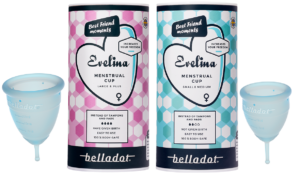Menstruation and menstrual cups
Menstruation and menstrual cups
Here we go again, as many women think about once a month. Some people welcome their monthly bleeding with gratitude – no unwanted pregnancy this time – while others are sad not to be bearing the child they wish for.
In English, menstruation is sometimes called the “curse”, something all women suffer from. In many cultures the woman is considered impure during the time of her bleeding. Perhaps this will remain in our modern society to some extent.
All the names and euphemisms that exist may be a sign that menstruation is still something we avoid mentioning. Instead, perhaps we should celebrate menstruation as one of the signs of female physical maturity.
Menstrual Cup – with the right feminine protection, the “curse” can feel easier to carry!
A menstrual cup is a silicone container that collects the blood. It is available in different sizes, emptied and cleaned a few times a day, as well as before each menstrual period. It is placed just inside the vaginal opening. The delicate pH balance of the vagina is not affected and the cup is hypoallergenic. If placed correctly, the menstrual cup remains tightly fitted during sports activities, swimming and during the night. It holds a lot of fluid and therefore does not need to be emptied very often. The menstrual cups can last for 5–10 years, making them good both for your purse and the environment. Belladot Evelina is a smooth menstrual cup in silicone. The menstrual cup is absolutely safe. Traditional menstrual protection can lead to problems like dehydration and disruption of the pH balance, and do not allow the same freedom as a menstrual cup. The Belladot Evelina Menstrual Cup is a really good choice!
Traditional protections
Sanitary pad – placed in the underwear to absorb the blood. They are stuck directly into the underwear with adhesive strips and usually have “wings” that protect the edge of the underwear. There are disposable pads or pads that can be washed and reused in the same way as fabric diapers. Pantyliners, a smaller and thinner type of pad, may be sufficient when the bleeding is light or at the end of the period. Having a pad can feel clumsy and give a moist feeling, even when the blood is absorbed. Moisture in the vaginal area increases the risk of fungal infection (candida). At night there is a risk of leakage. One-time pads cost hundreds of euro over a lifetime. Many pads are made every year, which contributes to the garbage mountain.
Tampon – a small cotton roll that is placed up inside the vagina and absorbs the blood. Tampons are removed using the string at the end. The tampon can dry out and adversely affect the fragile mucous membranes in the vagina. If the bleeding is light, there is a risk that tampon residues remain in the vagina when the tampon is removed, which may increase the risk of infection. Tampon sickness or Toxic Shock Syndrome is a serious bacterial disease that may be a risk in some cases if the tampon stays in for a long time, and the hygiene is not dealt with correctly. Tampons cost money, and bearing in mind the number used over a lifetime it’s a pretty expensive business.
Facts about menstruation
Menarche – the first bleeding usually occurs between 10 and 16 years of age. If the menstrual period has not started by around 16–17 years, it may be wise to talk to a doctor for examination. High stress, excessive exercise and eating disorders may delay or eliminate your period. Hormone levels can also have an effect.
Menstrual cycle – the time from the first day of the period to the first day of the next period is usually between 21 and 35 days. Bleeding begins about 14 days after ovulation, as long as no egg is fertilized. In some cases a minor bleeding may occur. Therefore, it is best to take a pregnancy test after unprotected sex if you want to be absolutely sure.
Menopause – this is when the time of fertility is over and the menstrual cycle ends. Onset is about one year after the last bleeding, usually sometime between 45 and 55 years of age.
Problems with menstruation
Many women suffer from pain during menstruation. Painkillers, heat and exercise can help. If the pain is very intense a gynaecological examination may be necessary. Medical problems such as endometriosis and myoma can cause severe pain for some women. Irritation, tension and swelling of the body, or PMS, is also a common problem.
In case of excessive bleeding, medicines are available. A normal amount of blood during a menstrual period is barely 100 millilitres, but this may vary.

